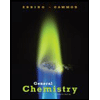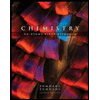
Concept explainers
Which compound in each of the following pairs would you expect to have the greater
dipole moment
Want to see the full answer?
Check out a sample textbook solution
Chapter 1 Solutions
Organic Chemistry - Standalone book
- Many important compounds in the chemical industry are derivatives of ethylene (C2H4). two of them are acrylonitrile and methyl methacrylate. Acrylonitrile Methyl methacrylate Complete the Lewis structures, showing all lone pairs. Give approximate values for bond angles a through f Give the hybridization of all carbon atoms. In acrylonitrile, how many of the atoms in the molecule must lie in the same plane? How many bonds and how many bonds are there in methyl methacrylate and acrylonitrile?arrow_forwardThere are two compounds with the molecular formula HN3. One is called hydrogen azide; the other is cyclotriazene. (a) Write the Lewis structure for each compound. (b) Designate the hybridization of each nitrogen in hydrogen azide. (c) What is the hybridization of each nitrogen in cyclotriazene? (d) How many sigma bonds are in hydrogen azide? In cyclotriazene? (e) How many pi bonds are in hydrogen azide? In cyclotriazene? (f) Give approximate values for the N-to-N-to-N bond angles in each molecule.arrow_forwardMinoxidil (C9H15N15O) is a compound produced by the Pharmacia Upjohn Company that has been approved as a treatment for some types of male pattern baldness. Note that in such shorthand ring structures, each point where lines meet is a carbon atom and that the hydrogen atoms bonded to the carbon atoms in the rings have been omitted. There will be four bonds to each carbon atom. a. Give the hybridization of the five nitrogen atoms in minoxidil. b. Give the hybridization of each of the nine carbon atoms in minoxidil. c. Give the approximate values for the bond angles marked a, b, c, d, e, and f. d. Including all the hydrogen atoms, how many bonds exist in minoxidil? e. How many bonds exist in minoxidil?arrow_forward
- Phosphoserine is a less-common amino acid. (a) Identify the hybridizations of atoms I through 5. (b) What are the approximate values of the bond angles A, B. C, and D? (c) What are the most polar bonds in the molecule?arrow_forwardWhat are the bond angles predicted by the VSEPR model about the carbon atom in the formate ion, HCO2? Considering that the bonds to this atom are not identical, would you expect the experimental values to agree precisely with the VSEPR values? How might they differ?arrow_forwardFluoromethane (CH3F, u=1.81 D) has a smaller dipole moment than chloromethane (CH3Cl u=1.87 D) even though fluorine is more electronegative than chlorine. Explain.arrow_forward
- Which compound in each of the following pairs would you expect to have the greaterdipole moment μ? Why?(a) HF or HCl (d) CHCl3 or CCl3F(b) HF or BF3 (e) CH3NH2 or CH3OH(c) (CH3)3CH or (CH3)3CCl (f) CH3NH2 or CH3NO2arrow_forwardThe dipole moments (dp) and boiling points (b.p.) of the following four molecular compounds are given below: CH3Cl (dp = 1.9; bp = -23.1 oC)) CH2Cl2 (dp =1.6; bp = 39.75 oC) CHCl3 (dp =1.03; bp = 61.5 oC) CCl4 (dp = 0.00 bp = 76.7 oC) Q: What types of intermolecular forces exist in each compound?arrow_forward17. Which of the following does have delocalized molecular orbitals? Z of N = 7, O = 8, H = 1, C = 6 Hint: in the followings the overall charge is shown in the parenthesis. a.C03(-2)b.CH4c.NH3d.H20arrow_forward
- Tetrafluoroethylene, C2F4, is the starting material for the synthesis of the polymer poly tetrafluoroethylene (PTFE), one form of which is known as Teflon. Tetrafluoroethylene has a dipole moment of zero. Propose a structural formula for this molecule.arrow_forwardWhich of the following molecules is most polar? (Na=1.0; C=2.5; H=2.5; Cl=3.0; F=4.0; O=3.5) a. h2o b. Nacl c. HF d. C2H6arrow_forwardMake three-dimensional drawings of the following molecules, and predict whether eachhas a dipole moment. If you expect a dipole moment, show its direction.(a) H2C꓿CH2(b) CHCl3(c) CH2Cl2(d) H2C꓿CCl2arrow_forward
 Chemistry: The Molecular ScienceChemistryISBN:9781285199047Author:John W. Moore, Conrad L. StanitskiPublisher:Cengage Learning
Chemistry: The Molecular ScienceChemistryISBN:9781285199047Author:John W. Moore, Conrad L. StanitskiPublisher:Cengage Learning Chemistry & Chemical ReactivityChemistryISBN:9781133949640Author:John C. Kotz, Paul M. Treichel, John Townsend, David TreichelPublisher:Cengage Learning
Chemistry & Chemical ReactivityChemistryISBN:9781133949640Author:John C. Kotz, Paul M. Treichel, John Townsend, David TreichelPublisher:Cengage Learning Chemistry & Chemical ReactivityChemistryISBN:9781337399074Author:John C. Kotz, Paul M. Treichel, John Townsend, David TreichelPublisher:Cengage Learning
Chemistry & Chemical ReactivityChemistryISBN:9781337399074Author:John C. Kotz, Paul M. Treichel, John Townsend, David TreichelPublisher:Cengage Learning Chemistry: Principles and PracticeChemistryISBN:9780534420123Author:Daniel L. Reger, Scott R. Goode, David W. Ball, Edward MercerPublisher:Cengage Learning
Chemistry: Principles and PracticeChemistryISBN:9780534420123Author:Daniel L. Reger, Scott R. Goode, David W. Ball, Edward MercerPublisher:Cengage Learning General Chemistry - Standalone book (MindTap Cour...ChemistryISBN:9781305580343Author:Steven D. Gammon, Ebbing, Darrell Ebbing, Steven D., Darrell; Gammon, Darrell Ebbing; Steven D. Gammon, Darrell D.; Gammon, Ebbing; Steven D. Gammon; DarrellPublisher:Cengage Learning
General Chemistry - Standalone book (MindTap Cour...ChemistryISBN:9781305580343Author:Steven D. Gammon, Ebbing, Darrell Ebbing, Steven D., Darrell; Gammon, Darrell Ebbing; Steven D. Gammon, Darrell D.; Gammon, Ebbing; Steven D. Gammon; DarrellPublisher:Cengage Learning Chemistry: An Atoms First ApproachChemistryISBN:9781305079243Author:Steven S. Zumdahl, Susan A. ZumdahlPublisher:Cengage Learning
Chemistry: An Atoms First ApproachChemistryISBN:9781305079243Author:Steven S. Zumdahl, Susan A. ZumdahlPublisher:Cengage Learning





